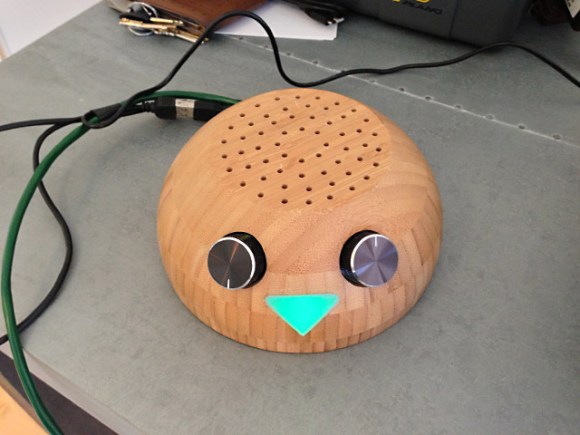
This anthropomorphized wood bowl will read Tweets out loud. It was built by [William Lindmeier] as part of his graduate work in the Interactive Telecommunications Program (ITP) at New York University. View the clip after the break to see and hear a list from his Twitter feed read in rather pleasant text-to-speech voices.
The electronics involved are rather convoluted. Inside the upturned bowl you’ll find both an Arduino and a Raspberry Pi. But that’s not the only thing that goes into this. The best sounding text-to-speech program [William] could find was for OSX, so there is a remote computer involved as well. But we think what makes this special is the concept and execution, not the level of hardware inefficiency.
The knob to the left sets the volume and is also responsible for powering down the device. The knob of the right lets you select from various Twitter lists. Each turn of the knob is responded to with a different LED color in the nose and a spoken menu label. You can get a quick overview of the project from this summary post.
















There are plenty of good free TTS voices for use with Festival the default aren’t so great but not terrible either; there are mbrola voices that can be used with it and if you don’t care for Freeness (OSX anyway) there are Cepstral voices you can buy which are far superior to Apple’s (and come in a variety of languages and dialects!) – work in linux.
Cool project, looks nice, but I’m a bit confused. It looks like from his blog he added an Arduino only because he needed an extra PWM pin for the LED. I’m no Raspberry Pi expert, but surely it’s possible to roll your own PWM on one of the other GPIO pins?
The Pi only has one PWM pin. But the rest are open to software PWM and there are several existing options out there for that.
Doesn’t the Pi give you enough control of the GPIO pins that you could just write your own PWM loop? Or is it complicated enough from the Linux environment that it’s easier to use a library?
This just needs a hand to turn itself off.
A bit convoluted like Mike said, but it seems to work very smoothly and I like the idea.
I’m wondering when people will have enough of these “twitter driven” devices. Shit’s been done a 1000 times for christsake and it was lame the first time.
quote: “I wrapped the Pi in a static-free bag because I was getting some short circuits when the components bumped into each other.”
Well ESD bags won’t be static free if they where not conductive, i wouldn’t consider it as an enclosure… (The pink bags are fine, they do not conduct.)
Those silver-colored ones *typically* have a buried aluminum layer, which doesn’t make the surface conductive; but rather acts as a Faraday cage.
Of course, if a couple of pins should scratch through to the conductive layer, you get an odd or defective bag, or Murphy’s law strikes in a multitude of other ways, all bets are off. Though you can often get away with it, running electronics in contact with an ESD bag is poor practice. I use uncoated paper, cardboard, or wood instead.
Ventilation for the Pi in there, although it’s probably adequate, isn’t particularly great either.
I love the anthropomorphic hardware- if it was mine I’d have it reading out news RSS feeds, but each to his own :)
festival should run on the pi shouldn’t it, would allow to eliminate the mac.
pico2wave (libttspico-utils) works just fine on the raspi.